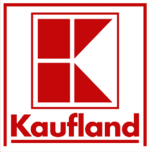Kaufland
 | |
| Private | |
| Industry | Retail |
| Founded | 1984 |
| Headquarters | Neckarsulm, Germany |
Key people | Frank Lehmann, CEO |
| Products | Discount hypermarkets |
| Parent | Schwarz Gruppe |
| Website | www.kaufland.com |

Kaufland [ˈkaʊ̯flant] is a German hypermarket chain, part of the Schwarz Gruppe which also owns Lidl and Handelshof. It opened its first store in 1984 in Neckarsulm and quickly expanded to become a leader in what was formerly West Germany. The chain operates over 1,000 stores in Germany, the Czech Republic, Slovakia, Poland, Romania, Bulgaria and Croatia.
Operations
The Kaufland Stiftung & Co. KG is part of the complex corporate structure of Schwarz-Beteiligungs-GmbH, which is 99.9% owned by Dieter Schwarz and the Dieter Schwarz Stiftung GmbH. Among the various land-purchase subsidiaries include the Schwarz-Property Management GmbH & Co. KG, the possession of the hypermarkets is in, and the land purchase goods mbH as operator of self-service markets.
Kaufland has:
- 55 stores in Bulgaria, 10 of which are in the capital, Sofia.
- 103 stores in Romania, 13 of which are in the capital, Bucharest.
| |
|
|
|
|
|---|---|---|---|---|
| 55 | 120+ | 168 | 103 | 46 |

History
The history of Kaufland began when Joseph Schwarz entered the Südfrüchte Großhandlung Lidl & Co. at Heilbronn as a shareholder in 1930, which was then renamed Lidl & Schwarz KG. In subsequent years it was the aim of the company to expand its range and become a food wholesale.
After the Second World War, the company was rebuilt: in 1954 it entered the A & O-chain. With Handels- und Fruchthof Heilbronn GmbH the first regional warehouse was opened in northern Wurttemberg. In 1964 the company expanded its range of products by opening a meat department. In 1968 the first Handelshof discount store was opened in Backnang, and in 1977 at the same place a hypermarket of the same name was established. After the death of Joseph Schwarz in 1977 his son Dieter Schwarz took over the management of the company. In 1984 the first Kaufland hypermarket was opened in Neckarsulm, the town being the seat of the company's headquarters since 1972.
After the reunification of Germany the Kaufland chain expanded into the Eastern German states and opened numerous markets. The first East German Kaufland store was opened in Meissen in 1990, the first Kaufmarkt SB Warenhaus opened in 1994 in Zwickau. The first department store outside of Germany was established in 1998 in Ostrava, Czech Republic. In subsequent years, the company established branches in Slovakia (since 2000), Croatia (2001), Poland (2001), Romania (2005) and Bulgaria (2006).
In 2006 and 2007, other store openings followed in Germany and Kaufland also took over shares of competitors. In February 2009 the corporation claimed to have 73,000 employees in Germany.[1]
In December 2009, Kaufland announced the building of a new meat processing plant in Heiligenstadt, Thuringia for a total of € 85 million until 2013. About 400 local employees will then deliver 45,000 tons of meat per year to around 600 stores of the corporation.
In January 2010, it was announced that Karl Lupus GmbH & Co. KG was cleared by antritrust authorities to sell their 12 stores of the famila Handels-Betriebe GmbH & Co. KG Rhein-Neckar and the Cash-&-Carry-Markt Lupus Food Service with 1,400 employees to Kaufland.[2]
On 1 January 2010, the Kaufland group had purchased all five Schleckerland drug stores in Ehingen, Geislingen, Tempe, Neu-Ulm, Schwäbisch Gmünd and all but the Neu-Ulm store had been converted to the Kaufland brand by then. The local Schleckerland was closed down because Kaufland was already present in Neu-Ulm.[3]
From 2011, all Handelshof stores will gradually be converted to the Kaufland brand and will be partly rebuilt and enlarged.
References
- ↑ "Kaufland investiert in Logistiknetz". February 2009. Archived from the original on 19 December 2009.
- ↑ "Aus Famila wird Kaufland: Alle Mitarbeiter übernommen". Pforzheimer Zeitung (in German). 19 January 2010.
- ↑ "Schleckerland macht zu". Schwäbische Zeitung. 25 November 2009.
External links
| Wikimedia Commons has media related to Kaufland. |
- Kaufland Germany
- Kaufland Bulgaria
- Kaufland Croatia
- Kaufland Czech Republic
- Kaufland Poland
- Kaufland Romania
- Kaufland Slovakia
- EBRD supports Kaufland’s expansion in eastern Europe